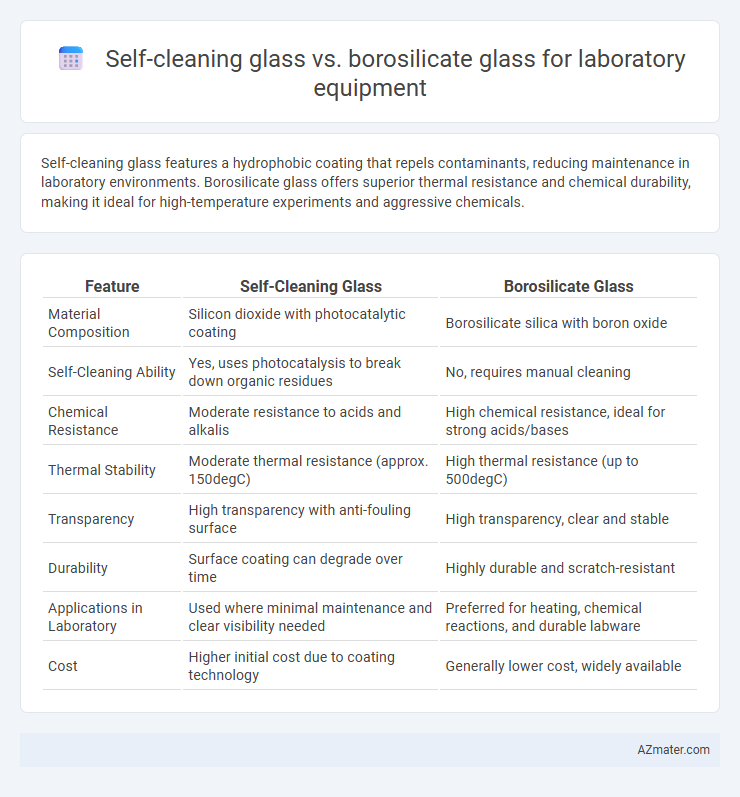Self-cleaning glass features a hydrophobic coating that repels contaminants, reducing maintenance in laboratory environments. Borosilicate glass offers superior thermal resistance and chemical durability, making it ideal for high-temperature experiments and aggressive chemicals.
Table of Comparison
| Feature | Self-Cleaning Glass | Borosilicate Glass |
|---|---|---|
| Material Composition | Silicon dioxide with photocatalytic coating | Borosilicate silica with boron oxide |
| Self-Cleaning Ability | Yes, uses photocatalysis to break down organic residues | No, requires manual cleaning |
| Chemical Resistance | Moderate resistance to acids and alkalis | High chemical resistance, ideal for strong acids/bases |
| Thermal Stability | Moderate thermal resistance (approx. 150degC) | High thermal resistance (up to 500degC) |
| Transparency | High transparency with anti-fouling surface | High transparency, clear and stable |
| Durability | Surface coating can degrade over time | Highly durable and scratch-resistant |
| Applications in Laboratory | Used where minimal maintenance and clear visibility needed | Preferred for heating, chemical reactions, and durable labware |
| Cost | Higher initial cost due to coating technology | Generally lower cost, widely available |
Introduction to Laboratory Glass Types
Laboratory glass types are critical for ensuring accuracy and durability in scientific experiments, with self-cleaning glass and borosilicate glass serving distinct purposes. Borosilicate glass is prized for its thermal resistance, chemical durability, and minimal thermal expansion, making it ideal for autoclaving and handling reactive substances. Self-cleaning glass incorporates photocatalytic coatings that break down organic residues, reducing maintenance but is less common in harsh laboratory environments compared to borosilicate's proven resilience.
Overview of Self-Cleaning Glass Technology
Self-cleaning glass technology utilizes a special photocatalytic coating, usually titanium dioxide, which reacts with sunlight to break down organic material and allows rainwater to wash away residues. This innovative surface reduces the need for manual cleaning, improving efficiency and maintaining clarity in laboratory environments. While borosilicate glass is prized for its thermal resistance and chemical durability, self-cleaning glass offers enhanced maintenance benefits, making it a complementary choice for certain laboratory applications.
Key Properties of Borosilicate Glass
Borosilicate glass is highly favored in laboratory equipment due to its exceptional thermal resistance, low coefficient of thermal expansion, and outstanding chemical durability, enabling it to withstand rapid temperature changes and exposure to corrosive substances. Unlike self-cleaning glass, which features a photocatalytic and hydrophilic coating to reduce surface deposits, borosilicate glass offers structural integrity and clarity without compromising chemical stability. Its resistance to thermal shock and ability to maintain transparency under harsh laboratory conditions make borosilicate glass a reliable choice for precise scientific applications.
Chemical Resistance Comparison
Self-cleaning glass typically features a photocatalytic coating that facilitates the breakdown of organic contaminants but may have limited chemical resistance compared to borosilicate glass, which offers exceptional resistance to acids, alkalis, and solvents commonly used in laboratories. Borosilicate glass's low thermal expansion and high durability make it ideal for harsh chemical environments, ensuring minimal degradation and contamination risk during repeated experiments. While self-cleaning glass improves maintenance efficiency, borosilicate glass remains the preferred choice for chemically resistant laboratory equipment requiring long-term reliability.
Thermal Stability and Performance
Self-cleaning glass offers moderate thermal stability suitable for routine laboratory applications but may degrade under extreme temperature variations, limiting its use in high-heat experiments. Borosilicate glass excels with exceptional thermal resistance, tolerating rapid temperature changes up to 500degC without cracking, making it ideal for laboratory equipment requiring high thermal performance. Its low coefficient of thermal expansion ensures durability and precision in thermal cycling, outperforming self-cleaning glass in rigorous scientific environments.
Maintenance and Cleaning Requirements
Self-cleaning glass reduces maintenance by using photocatalytic coatings that break down organic residues, minimizing manual cleaning and chemical use in laboratory equipment. Borosilicate glass, known for its chemical and thermal resistance, requires regular manual cleaning to remove contaminants and prevent residue buildup, often involving strong detergents or acid washes. Choosing self-cleaning glass can lower downtime and contamination risks, while borosilicate glass demands thorough maintenance to maintain clarity and durability during repeated lab processes.
Transparency and Optical Clarity
Self-cleaning glass features a photocatalytic coating that maintains high transparency by reducing surface contaminants, ensuring consistent optical clarity ideal for laboratory environments requiring precise visual assessments. Borosilicate glass offers superior chemical resistance and thermal stability but may accumulate residues more readily, potentially compromising optical clarity without frequent cleaning. For applications prioritizing uninterrupted transparency and minimal maintenance, self-cleaning glass provides a significant advantage over borosilicate glass in maintaining clear, distortion-free visualization.
Cost Analysis: Self-Cleaning vs Borosilicate Glass
Self-cleaning glass tends to have a higher upfront cost compared to borosilicate glass due to its advanced surface coatings and technology. Borosilicate glass, known for its thermal resistance and chemical durability, offers a cost-effective option widely used in laboratory settings. Over time, self-cleaning glass can reduce maintenance expenses, but the initial investment remains significantly above that of traditional borosilicate glass.
Suitability for Laboratory Applications
Self-cleaning glass enhances laboratory efficiency by reducing manual cleaning and minimizing contamination risks, making it ideal for experiments requiring sterile conditions. Borosilicate glass offers superior thermal resistance, chemical durability, and mechanical strength, ensuring reliability for high-temperature reactions and rigorous chemical handling. For applications demanding both cleanliness and robustness, selecting the appropriate glass depends on the specific laboratory requirements concerning temperature tolerance and contamination control.
Final Recommendation: Choosing the Right Glass
Self-cleaning glass offers enhanced durability and reduces contamination risks by minimizing residue buildup, making it ideal for applications requiring frequent cleaning and sterile environments. Borosilicate glass provides exceptional thermal resistance and chemical durability, suitable for high-temperature reactions and aggressive chemical handling in laboratory settings. Selecting the right glass depends on prioritizing either ease of maintenance and contamination control, favoring self-cleaning glass, or superior thermal stability and chemical resistance, where borosilicate glass excels.

Infographic: Self-cleaning glass vs Borosilicate glass for Laboratory equipment
 azmater.com
azmater.com